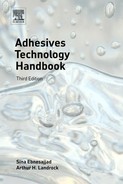Table of Contents
Chapter 1. Introduction and Adhesion Theories
1.1 Definition of Adhesives and Adhesive Bonding
1.3 Classification of Adhesives
1.4 Advantages and Disadvantages of Joining Using Adhesives
1.5 Requirements of a Good Bond
1.6 Introduction to Theories of Adhesion
1.7 Definition of Failure Modes
1.8 Mechanisms of Bond Failure
Chapter 2. Surface Tension and Its Measurement
2.5 Contact Angle (Young’s Equation)
2.6 Effect of Temperature on Surface Tension
2.7 Surface Tension Measurement
Chapter 3. Material Surface Preparation Techniques
3.3 Surface Treatment of Metals
3.4 Cleaning (Degreasing) Metals
3.7 Surface Treatment of Plastics
3.8 Methods for Evaluating Effectiveness of Surface Preparation
Chapter 4. Classification of Adhesives and Compounds
4.2 Adhesive Composition Formulation
4.3 Classification of Adhesives
Chapter 5. Characteristics of Adhesive Materials
5.2 Allyl Diglycol Carbonate (CR-39)
5.3 Alloyed or Modified (Two-Polymer) Adhesives
5.4 Anaerobic Adhesives/Sealants
5.5 Aromatic Polymer Adhesives (Polyaromatics)
5.16 Epoxy-Polysulfide Adhesives
5.17 Film and Tape Adhesives (See also Section 5.3)
5.20 Inorganic Adhesives (Cements)
5.21 Melamine-Formaldehyde Adhesives (Melamines)
5.22 Microencapsulated Adhesives
5.24 Neoprene (Polychloroprene) Adhesives
5.25 Neoprene-Phenolic Adhesives
5.26 Nitrile-Epoxy (Elastomer-Epoxy) Adhesives
5.27 Nitrile-Phenolic Adhesives
5.36 Polyisobutylene Adhesives
5.41 Polyvinyl Acetal Adhesives
5.42 Polyvinyl Acetate Adhesives
5.43 Polyvinyl Alcohol Adhesives
5.44 Polyvinyl Butyral Adhesives
5.45 Premixed Frozen Adhesives
5.46 Pressure-Sensitive Adhesives
5.47 Resorcinol-Formaldehyde Adhesives
5.50 Thermoplastic Resin Adhesives
5.51 Thermoplastic Rubber (For Use in Adhesives)
5.52 Thermosetting Resin Adhesives
5.54 Urea-Formaldehyde Adhesives (Ureas)
5.57 Polyvinyl Formal-Phenolics
5.58 Polyvinyl Butyral-Phenolics
Chapter 6. Adhesives for Special Adherends
6.4 Thermosetting Plastics (Thermosets)
6.5 Reinforced Plastics/Composites
7.3 Methods of Improving Joint Efficiency
7.6 Peeling of Adhesive Joints
7.10 Joints for Plastics and Elastomers
7.11 Stress Analysis of Adhesive Joints
7.12 Optimizing Adhesive Bonding Through Joint Design—A Practical Approach
Chapter 8. Adhesive Applications and Bonding Processes
8.5 Methods of Adhesive Application
Chapter 9. Solvent Cementing of Plastics
9.3 Solvents for Specific Polymers
9.4 Solvent Cementing—A Commercial Perspective
Chapter 10. Adhesives for Medical and Dental Applications
10.3 Synthetic and Semisynthetic Adhesives
10.5 Test Methods to Characterize Strength of Tissue Adhesives
10.6 Medical and Dental Applications of Adhesives
10.8 Dental Applications of Adhesives
Chapter 11. Durability of Adhesive Bonds
11.3 Low and Cryogenic Temperatures
11.4 Humidity and Water Immersion
11.12 Adhesive Bond Durability—A Commercial Perspective
Chapter 12. Testing of Adhesive Bonds
12.10 Compilation of Test Methods and Practices
13.2 Incoming Material Control
Chapter 14. Safety, Environmental, and Economic Aspects, and Future Trends
